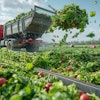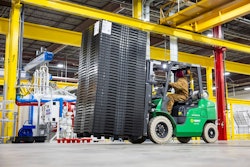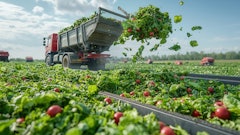
Food waste has become the grocery sector's big secret – quietly draining billions in revenue, eroding brand credibility, and fueling environmental concerns that extend far beyond the store exit. Research shows that one-third of all food produced globally goes to waste, creating a staggering financial and moral challenge. In an era of razor-thin margins and heightened consumer scrutiny, grocery executives can't afford to treat waste as a mere line item. Waste reduction has emerged as the next big financial metric, carrying as much weight as revenue growth and customer loyalty.
Here are several major trends redefining how forward-thinking grocers tackle waste: sophisticated inventory management technology, "waste-to-value" solutions, shifting regulations, food donation networks, and direct consumer engagement.
Attacking food waste isn't just about doing good – it's a strategic imperative that can shore up profit margins, strengthen brand equity, and prepare businesses for an evolving marketplace.
Smart inventory management solutions
Intelligent inventory solutions are turning the tide against food waste. Today's purpose-built waste reduction systems do better than guess: they use predictive analytics and machine learning that look at sales trends, local demand patterns, external factors like weather, and even seasonal events that might boost foot traffic. AI-powered forecasting tools can significantly reduce fresh item waste while maintaining in-stock rates, though implementation typically requires a calibration period. With improved inventory visibility, store managers can more accurately manage surges or drops in demand, meaning less overstock – and fewer crates of produce rotting in the back room.
Crucially, better inventory intelligence creates a natural bridge to smarter markdown management. Rather than marking down items in a haphazard, too-late approach, forward-thinking retailers implement structured markdown processes informed by the same data that drives their inventory decisions. Leading retailers have adopted markdown pricing solutions that determine the optimal price point – alerting systems that let their associates know exactly where, when, and at what price an item needs to be reduced to prevent it from going to waste.
Turning garbage into profit
Waste streams are evolving into viable revenue streams. A new generation of companies is taking surplus produce, spent grains, and other manufacturing by-products and turning them into profitable product lines – from soups and snacks to premium beverages and ingredients. This trend, often called "upcycling," repositions what was previously garbage as a market differentiator. Grocery executives with an eye on the future are integrating these upcycled options on their shelves to entice eco-conscious shoppers. This upcycling trend is manifesting in two powerful ways.
First, retailers themselves are creating in-house programs: several North American retailers turn bruised produce into fresh-pressed juices, and some international chains, like a major UK grocery retailer, transform unsold baguettes into frozen garlic bread. Second, and equally impactful, grocers are forming strategic partnerships with food producers and local startups to transform "ugly" produce or offcuts into co-branded products.
While upcycling initiatives often require initial investment in processing equipment and staff training, retailers typically see positive ROI through combined waste disposal savings and new revenue streams. Don't see imperfect produce or surplus as a nuisance. Instead, treat them as an innovation pipeline. With strong partner ecosystems, your unsold or cosmetically flawed items can become tomorrow's brand-building hero products.
Policy shifts and regulations
Legislators are raising the stakes for retailers. While food waste regulations have existed in various U.S. states for years, the regulatory landscape is now evolving toward unprecedented granularity. The next frontier of legislation targets ingredient-level tracking—following items from production through the entire supply chain to store shelves.
Policies around date labeling are also under scrutiny. Confusion around the meaning of "best before,"(indicating quality) "use by,"(indicating safety) and "sell by" (for inventory management) labels have fueled household-level waste, leading to calls for simplified or standardized labels. California's SB 1383 is a prime example of aggressive measures aimed at reducing food waste. The law sets ambitious targets for 2025: 75% less organic waste sent to landfills and 20% of unsold, still-edible food sent to food recovery organizations. Organic waste in landfills emits 20% of the state's methane, a climate super pollutant that heats 84 times more than carbon dioxide, and air pollutants like PM 2.5, which contribute to health conditions like asthma.
Looking beyond current requirements, federal agencies are already signaling intentions to follow pioneering states with stricter nationwide standards. The EPA's national goal to cut food waste 50% by 2030 foreshadows more aggressive regulations to come. Forward-thinking U.S. retailers who study these policy trajectories can prepare strategically while their competitors scramble to react.
Put bluntly, half-measures will soon be insufficient. For major chains, anticipating these regulations could help them avoid hefty fines, reputational damage, and operational disruptions. Leaders who proactively integrate these practices not only ensure compliance but also gain a competitive advantage.
Food donation networks
Surplus donation is another way retailers are shifting from a feel-good side note to a structured operational channel. Today, many major chains have formal partnerships with food banks and nonprofits, facilitated by specialized apps and data systems. These streamlined efforts ensure that fresh foods – meats, dairy, produce – get safely donated rather than tossed. The result is a dramatic increase in the volume and nutritional quality of donations.
Beyond the altruistic angle, this approach makes sound business sense. Every item donated reduces disposal fees, while generating positive community relations. Large grocers that cultivate these networks experience reputational benefits – shoppers appreciate seeing a store that respects food enough to donate rather than trash it. In my view, it's also a brand differentiator: when you donate tens of thousands of pounds of groceries to local organizations, you endear yourself to employees, local governments, and customers alike.
Waste reduction as a core business strategy
It's time to elevate food waste from a covert profit drain and back-office nuisance to a central operational metric, tracked and managed in the same way we do sales, labor costs, and on-shelf availability. From the boardroom's vantage point, investing in smart forecasting tools, forging waste-to-value partnerships, and embracing policy shifts is not a bonus – it's the cost of doing business in a world that demands efficiency, accountability, and environmental stewardship.
If we are serious about driving growth and building trust among shoppers, stakeholders, and employees alike, we have to make meaningful, measurable waste reduction a top priority. The research suggests that nothing we do as retailers – no discount campaign, fresh aisle redesign, or holiday promotion – will resonate as powerfully as a tangible commitment to solving one of the industry's biggest blind spots. At the end of the day, we owe it to our bottom lines, our communities, and our planet to waste less and win more.


















